NRS174 Clinical Reasoning Report: Mrs. Brown's Case Analysis
VerifiedAdded on 2023/06/05
|10
|2138
|122
Report
AI Summary
This report presents a clinical reasoning analysis of Mrs. Brown, a 73-year-old patient attending the hospital for a wound dressing change. The report details the nurse's assessment, including vital signs revealing hypotension, irregular pulse, and tachypnea, along with the patient's history of diabetes, osteoarthritis, and medication use. It identifies clinical issues such as a foot ulcer and potential diabetes-related complications. The report establishes two main goals: managing diabetes mellitus and managing the foot ulcer, with specific, measurable, achievable, relevant, and time-limited (SMART) objectives. It outlines nursing interventions focusing on glucose monitoring, medication adherence, diet, and wound care, including debridement if necessary. The evaluation section emphasizes the need for lifestyle modifications, regular wound checks, pain assessments, and the potential for amputation if the condition worsens, highlighting the importance of alcohol cessation and appropriate medication and dressing to prevent infection. The report references relevant literature on diabetic foot ulcers and nursing interventions.
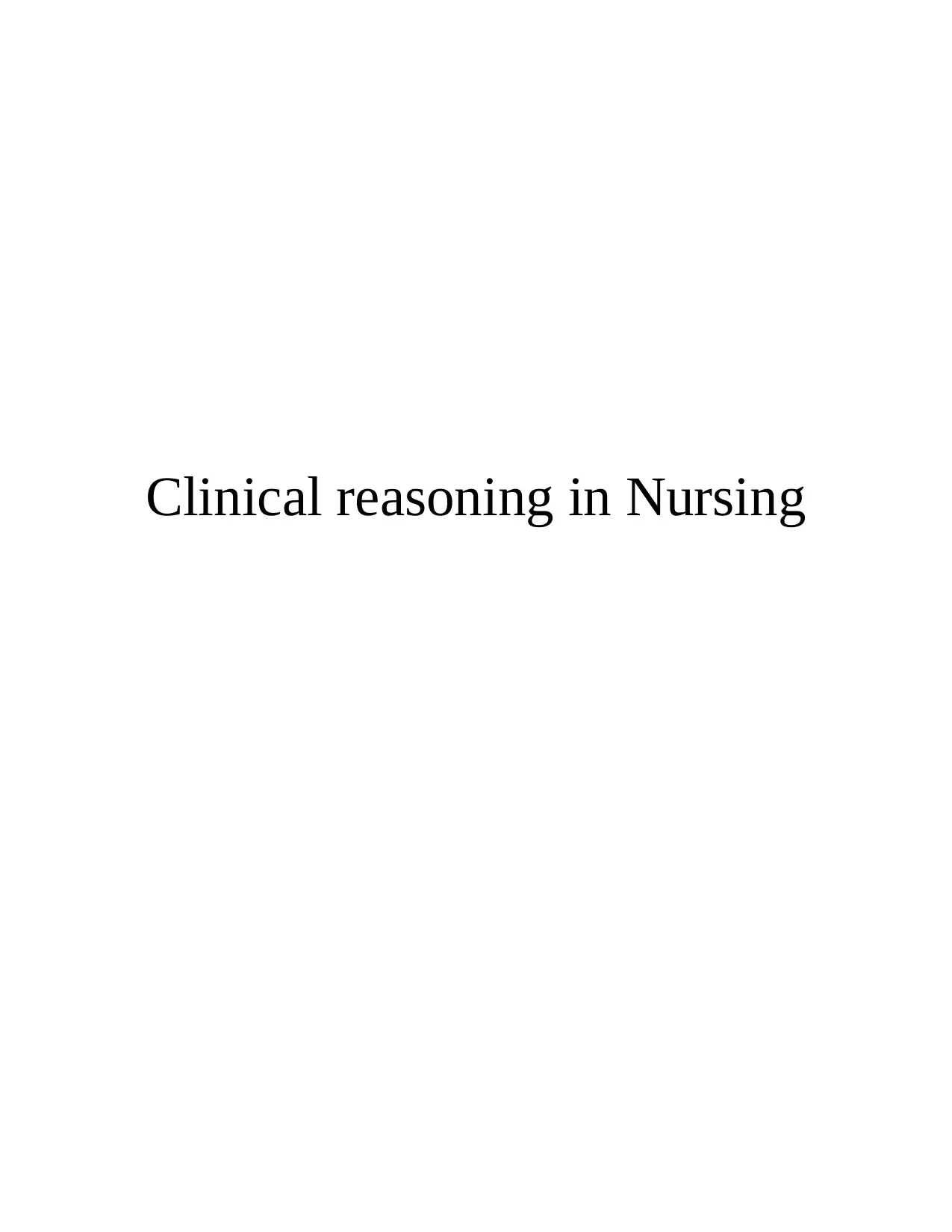
Clinical reasoning in Nursing
Paraphrase This Document
Need a fresh take? Get an instant paraphrase of this document with our AI Paraphraser
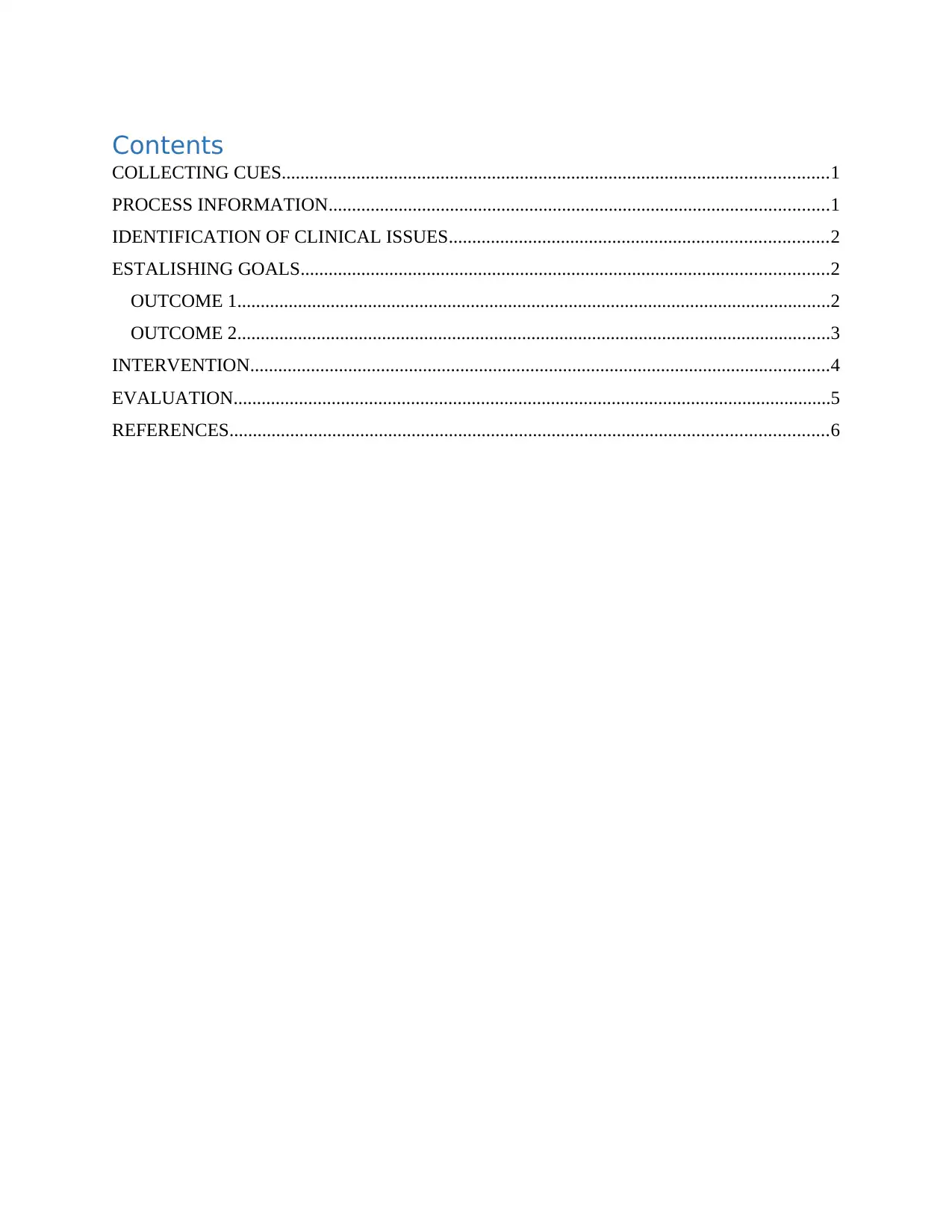
Contents
COLLECTING CUES.....................................................................................................................1
PROCESS INFORMATION...........................................................................................................1
IDENTIFICATION OF CLINICAL ISSUES.................................................................................2
ESTALISHING GOALS.................................................................................................................2
OUTCOME 1...............................................................................................................................2
OUTCOME 2...............................................................................................................................3
INTERVENTION............................................................................................................................4
EVALUATION................................................................................................................................5
REFERENCES................................................................................................................................6
COLLECTING CUES.....................................................................................................................1
PROCESS INFORMATION...........................................................................................................1
IDENTIFICATION OF CLINICAL ISSUES.................................................................................2
ESTALISHING GOALS.................................................................................................................2
OUTCOME 1...............................................................................................................................2
OUTCOME 2...............................................................................................................................3
INTERVENTION............................................................................................................................4
EVALUATION................................................................................................................................5
REFERENCES................................................................................................................................6

⊘ This is a preview!⊘
Do you want full access?
Subscribe today to unlock all pages.

Trusted by 1+ million students worldwide
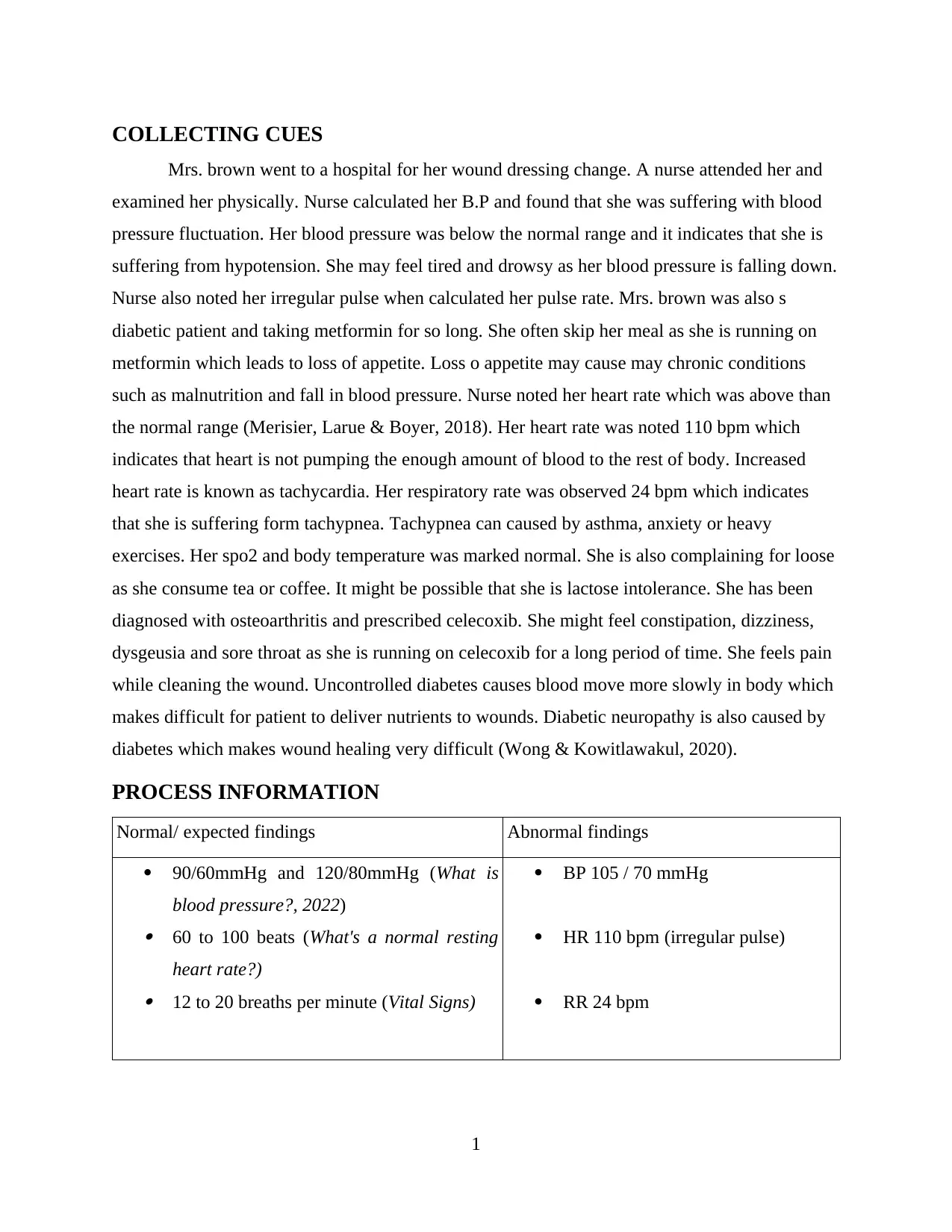
COLLECTING CUES
Mrs. brown went to a hospital for her wound dressing change. A nurse attended her and
examined her physically. Nurse calculated her B.P and found that she was suffering with blood
pressure fluctuation. Her blood pressure was below the normal range and it indicates that she is
suffering from hypotension. She may feel tired and drowsy as her blood pressure is falling down.
Nurse also noted her irregular pulse when calculated her pulse rate. Mrs. brown was also s
diabetic patient and taking metformin for so long. She often skip her meal as she is running on
metformin which leads to loss of appetite. Loss o appetite may cause may chronic conditions
such as malnutrition and fall in blood pressure. Nurse noted her heart rate which was above than
the normal range (Merisier, Larue & Boyer, 2018). Her heart rate was noted 110 bpm which
indicates that heart is not pumping the enough amount of blood to the rest of body. Increased
heart rate is known as tachycardia. Her respiratory rate was observed 24 bpm which indicates
that she is suffering form tachypnea. Tachypnea can caused by asthma, anxiety or heavy
exercises. Her spo2 and body temperature was marked normal. She is also complaining for loose
as she consume tea or coffee. It might be possible that she is lactose intolerance. She has been
diagnosed with osteoarthritis and prescribed celecoxib. She might feel constipation, dizziness,
dysgeusia and sore throat as she is running on celecoxib for a long period of time. She feels pain
while cleaning the wound. Uncontrolled diabetes causes blood move more slowly in body which
makes difficult for patient to deliver nutrients to wounds. Diabetic neuropathy is also caused by
diabetes which makes wound healing very difficult (Wong & Kowitlawakul, 2020).
PROCESS INFORMATION
Normal/ expected findings Abnormal findings
90/60mmHg and 120/80mmHg (What is
blood pressure?, 2022) 60 to 100 beats (What's a normal resting
heart rate?) 12 to 20 breaths per minute (Vital Signs)
BP 105 / 70 mmHg
HR 110 bpm (irregular pulse)
RR 24 bpm
1
Mrs. brown went to a hospital for her wound dressing change. A nurse attended her and
examined her physically. Nurse calculated her B.P and found that she was suffering with blood
pressure fluctuation. Her blood pressure was below the normal range and it indicates that she is
suffering from hypotension. She may feel tired and drowsy as her blood pressure is falling down.
Nurse also noted her irregular pulse when calculated her pulse rate. Mrs. brown was also s
diabetic patient and taking metformin for so long. She often skip her meal as she is running on
metformin which leads to loss of appetite. Loss o appetite may cause may chronic conditions
such as malnutrition and fall in blood pressure. Nurse noted her heart rate which was above than
the normal range (Merisier, Larue & Boyer, 2018). Her heart rate was noted 110 bpm which
indicates that heart is not pumping the enough amount of blood to the rest of body. Increased
heart rate is known as tachycardia. Her respiratory rate was observed 24 bpm which indicates
that she is suffering form tachypnea. Tachypnea can caused by asthma, anxiety or heavy
exercises. Her spo2 and body temperature was marked normal. She is also complaining for loose
as she consume tea or coffee. It might be possible that she is lactose intolerance. She has been
diagnosed with osteoarthritis and prescribed celecoxib. She might feel constipation, dizziness,
dysgeusia and sore throat as she is running on celecoxib for a long period of time. She feels pain
while cleaning the wound. Uncontrolled diabetes causes blood move more slowly in body which
makes difficult for patient to deliver nutrients to wounds. Diabetic neuropathy is also caused by
diabetes which makes wound healing very difficult (Wong & Kowitlawakul, 2020).
PROCESS INFORMATION
Normal/ expected findings Abnormal findings
90/60mmHg and 120/80mmHg (What is
blood pressure?, 2022) 60 to 100 beats (What's a normal resting
heart rate?) 12 to 20 breaths per minute (Vital Signs)
BP 105 / 70 mmHg
HR 110 bpm (irregular pulse)
RR 24 bpm
1
Paraphrase This Document
Need a fresh take? Get an instant paraphrase of this document with our AI Paraphraser

A respiratory rate of 24 in Mrs. Brown in indicates the possibility of a serious event
which can turn adverse in the coming hours. It is crucial to acknowledge these changes as a
respiratory rate under 12 or over 25 breaths per minute is considered abnormal and medical
assistance is required. An irregular pulse rate in the patient can be a cause of arrhythmia which
signifies that the heart might be out of its normal rhythm (Aldana & Khachemoune, 2020). There
is a fluttering sensation which can range from being a minor inconvenience or discomfort to a
fatal issue of the heart. The reason behind these fluttering sensations might be anxiety or
exposure to stressful situations. The administration of stimulants and illegal drugs must be
avoided to calm irregular palpitations. 105 over 70 mmHg indicates low blood pressure or
hypotension. Hypotension is characterized by dizziness, light-headedness, fatigue and fainting
sensations. The patient might also have trouble concentrating and conditions of nausea. There are
various causes of low blood pressure such as loss of blood through bleeding from a certain area
or low body temperature. Mrs. Brown is Complaining of 3/10 ‘throbbing’ pain around the
wound area (at rest), which might indicate the presence of an open sore or wound and even an
abrasion. There might be a possibility of damaged tissue where sensory receptors are
transmitting the signals to the spinal cord as pain or ache.
IDENTIFICATION OF CLINICAL ISSUES
The patient here has an abrasion or skin ulcer at her foot which is causing her throbbing
pain while at rest. Mrs. Brown is also also suffering from Type II Diabetes mellitus, which
indicates the likelihood of development of foot ulcer. Patients exposed to high insulin levels are
at a higher risk of developing foot ulcers. Mrs. Brown also reported loose motions and
inconsistency in her diet. The presence of skin ulcer at her foot showcases low blood pressure in
her body as indicated by her physical assessment. The old day also has osteoarthritis and had a
total knee replacement in the year 2010.
ESTALISHING GOALS
OUTCOME 1
Management of Diabetes Mellitus through SMART goals criteria
Checklist
Specific The goal for management of Diabetes is to
2
which can turn adverse in the coming hours. It is crucial to acknowledge these changes as a
respiratory rate under 12 or over 25 breaths per minute is considered abnormal and medical
assistance is required. An irregular pulse rate in the patient can be a cause of arrhythmia which
signifies that the heart might be out of its normal rhythm (Aldana & Khachemoune, 2020). There
is a fluttering sensation which can range from being a minor inconvenience or discomfort to a
fatal issue of the heart. The reason behind these fluttering sensations might be anxiety or
exposure to stressful situations. The administration of stimulants and illegal drugs must be
avoided to calm irregular palpitations. 105 over 70 mmHg indicates low blood pressure or
hypotension. Hypotension is characterized by dizziness, light-headedness, fatigue and fainting
sensations. The patient might also have trouble concentrating and conditions of nausea. There are
various causes of low blood pressure such as loss of blood through bleeding from a certain area
or low body temperature. Mrs. Brown is Complaining of 3/10 ‘throbbing’ pain around the
wound area (at rest), which might indicate the presence of an open sore or wound and even an
abrasion. There might be a possibility of damaged tissue where sensory receptors are
transmitting the signals to the spinal cord as pain or ache.
IDENTIFICATION OF CLINICAL ISSUES
The patient here has an abrasion or skin ulcer at her foot which is causing her throbbing
pain while at rest. Mrs. Brown is also also suffering from Type II Diabetes mellitus, which
indicates the likelihood of development of foot ulcer. Patients exposed to high insulin levels are
at a higher risk of developing foot ulcers. Mrs. Brown also reported loose motions and
inconsistency in her diet. The presence of skin ulcer at her foot showcases low blood pressure in
her body as indicated by her physical assessment. The old day also has osteoarthritis and had a
total knee replacement in the year 2010.
ESTALISHING GOALS
OUTCOME 1
Management of Diabetes Mellitus through SMART goals criteria
Checklist
Specific The goal for management of Diabetes is to
2
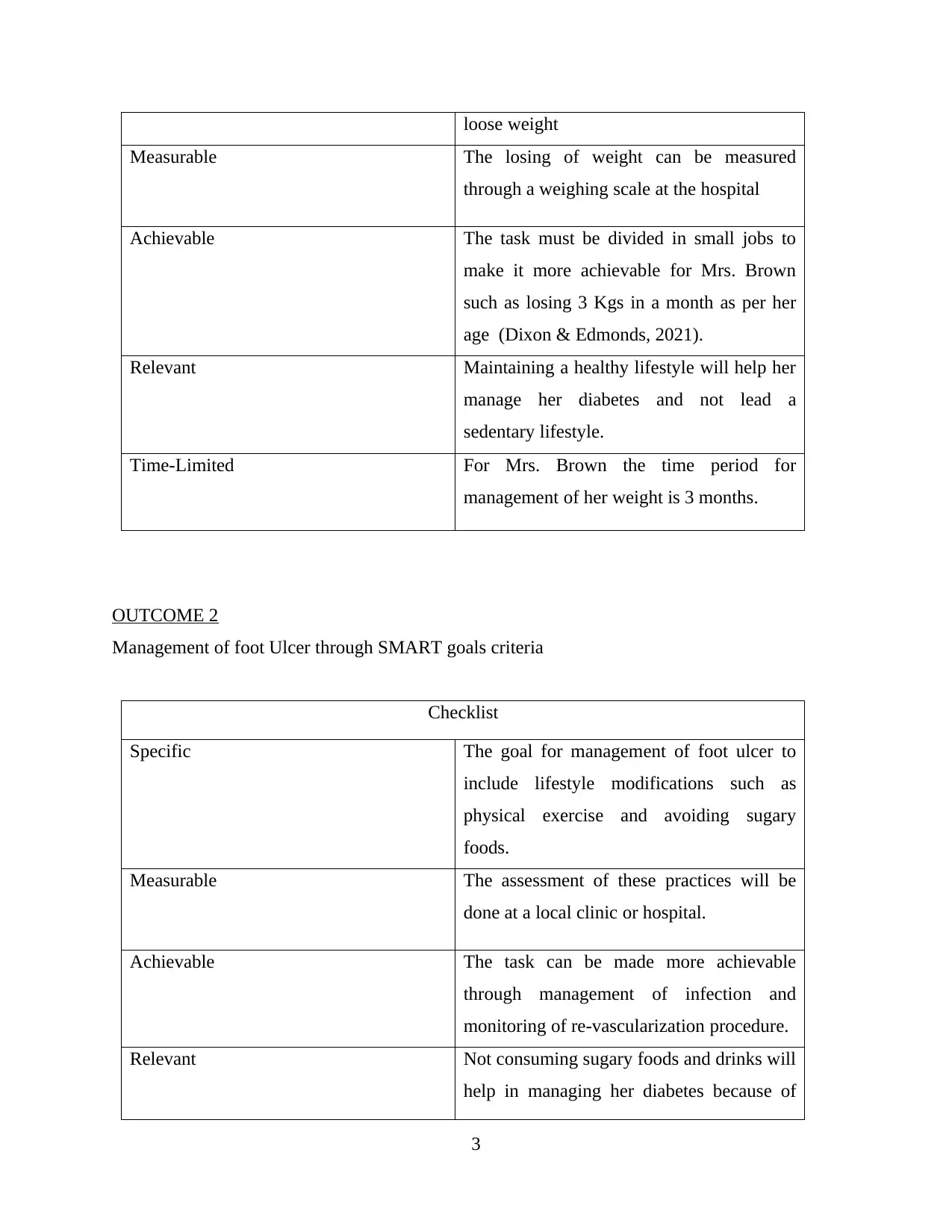
loose weight
Measurable The losing of weight can be measured
through a weighing scale at the hospital
Achievable The task must be divided in small jobs to
make it more achievable for Mrs. Brown
such as losing 3 Kgs in a month as per her
age (Dixon & Edmonds, 2021).
Relevant Maintaining a healthy lifestyle will help her
manage her diabetes and not lead a
sedentary lifestyle.
Time-Limited For Mrs. Brown the time period for
management of her weight is 3 months.
OUTCOME 2
Management of foot Ulcer through SMART goals criteria
Checklist
Specific The goal for management of foot ulcer to
include lifestyle modifications such as
physical exercise and avoiding sugary
foods.
Measurable The assessment of these practices will be
done at a local clinic or hospital.
Achievable The task can be made more achievable
through management of infection and
monitoring of re-vascularization procedure.
Relevant Not consuming sugary foods and drinks will
help in managing her diabetes because of
3
Measurable The losing of weight can be measured
through a weighing scale at the hospital
Achievable The task must be divided in small jobs to
make it more achievable for Mrs. Brown
such as losing 3 Kgs in a month as per her
age (Dixon & Edmonds, 2021).
Relevant Maintaining a healthy lifestyle will help her
manage her diabetes and not lead a
sedentary lifestyle.
Time-Limited For Mrs. Brown the time period for
management of her weight is 3 months.
OUTCOME 2
Management of foot Ulcer through SMART goals criteria
Checklist
Specific The goal for management of foot ulcer to
include lifestyle modifications such as
physical exercise and avoiding sugary
foods.
Measurable The assessment of these practices will be
done at a local clinic or hospital.
Achievable The task can be made more achievable
through management of infection and
monitoring of re-vascularization procedure.
Relevant Not consuming sugary foods and drinks will
help in managing her diabetes because of
3
⊘ This is a preview!⊘
Do you want full access?
Subscribe today to unlock all pages.

Trusted by 1+ million students worldwide

which the patient's foot ulcer can heal
(Singh, Gupta & Chanda, 2021).
Time-Limited For Mrs. Brown the time period for
management of ulcer is 2 months.
INTERVENTION
Nursing interventions for diabetic foot ulcers will include the following measures:
Regularly assessing the patient for glucose monitoring and reviewing factors that have
lead to glucose instability in Mrs. Brown. It is also crucial for nurses to educate the
patient about the working of their antidiabetic medications in a simple manner. Some
other practices that can be followed by nurses during intervention include frequent blood
check-ups, carbohydrate counting and assessing the working of insulin pump. Promotion
of self care management and educating the client on wound care to prevent the possibility
of amputation of leg (Eleftheriadou & et. al., 2021) . The injection sites in patient must be
monitored periodically to prevent the possibility of infection. Assessing the patient for
related complications based on their symptoms.
Medication adherence and a healthy diet: It is important for nurses to ensure adherence
to the therapeutic regimen of Mrs. Brown to promote perfusion of tissues. Encouraging
the administration of fluids to prevent the possibility of fluid volume deficiency in the
body. Educating the patient about choosing healthier fats and cutting down on sugar and
alcohol. Complying with the treatment prescribed through patient education decreases the
risk of complications. Some other factors that are responsible in the management of
diabetes are a balanced diet and regular exercising. The monitoring and assessing of
patient's bA1c-glycosylated haemoglobin along with adequacy of nutritional intake (Kim
& Han, 2020). Any signs of anxiety, tremors or slurring of speech must be assessed and
treated with 50% dextrose.
Wound Dressings: The presence of foot ulcer in should be examined and measures for
prevention of infection must be implemented. The patient reports persistent pain in her
wound because of which removal of dead skin or tissue, commonly called as
Debridement must be performed to help the healing process. Applying medication to the
4
(Singh, Gupta & Chanda, 2021).
Time-Limited For Mrs. Brown the time period for
management of ulcer is 2 months.
INTERVENTION
Nursing interventions for diabetic foot ulcers will include the following measures:
Regularly assessing the patient for glucose monitoring and reviewing factors that have
lead to glucose instability in Mrs. Brown. It is also crucial for nurses to educate the
patient about the working of their antidiabetic medications in a simple manner. Some
other practices that can be followed by nurses during intervention include frequent blood
check-ups, carbohydrate counting and assessing the working of insulin pump. Promotion
of self care management and educating the client on wound care to prevent the possibility
of amputation of leg (Eleftheriadou & et. al., 2021) . The injection sites in patient must be
monitored periodically to prevent the possibility of infection. Assessing the patient for
related complications based on their symptoms.
Medication adherence and a healthy diet: It is important for nurses to ensure adherence
to the therapeutic regimen of Mrs. Brown to promote perfusion of tissues. Encouraging
the administration of fluids to prevent the possibility of fluid volume deficiency in the
body. Educating the patient about choosing healthier fats and cutting down on sugar and
alcohol. Complying with the treatment prescribed through patient education decreases the
risk of complications. Some other factors that are responsible in the management of
diabetes are a balanced diet and regular exercising. The monitoring and assessing of
patient's bA1c-glycosylated haemoglobin along with adequacy of nutritional intake (Kim
& Han, 2020). Any signs of anxiety, tremors or slurring of speech must be assessed and
treated with 50% dextrose.
Wound Dressings: The presence of foot ulcer in should be examined and measures for
prevention of infection must be implemented. The patient reports persistent pain in her
wound because of which removal of dead skin or tissue, commonly called as
Debridement must be performed to help the healing process. Applying medication to the
4
Paraphrase This Document
Need a fresh take? Get an instant paraphrase of this document with our AI Paraphraser
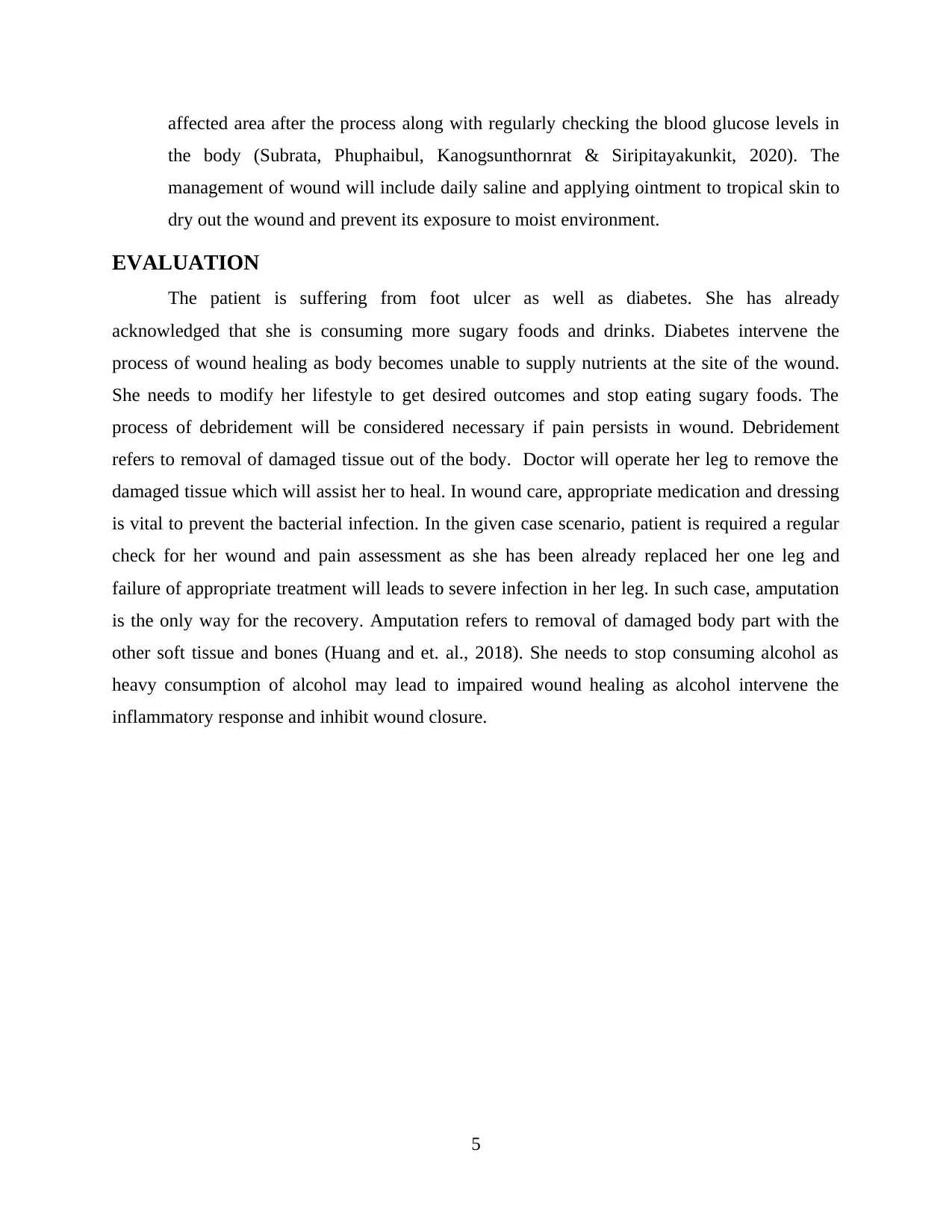
affected area after the process along with regularly checking the blood glucose levels in
the body (Subrata, Phuphaibul, Kanogsunthornrat & Siripitayakunkit, 2020). The
management of wound will include daily saline and applying ointment to tropical skin to
dry out the wound and prevent its exposure to moist environment.
EVALUATION
The patient is suffering from foot ulcer as well as diabetes. She has already
acknowledged that she is consuming more sugary foods and drinks. Diabetes intervene the
process of wound healing as body becomes unable to supply nutrients at the site of the wound.
She needs to modify her lifestyle to get desired outcomes and stop eating sugary foods. The
process of debridement will be considered necessary if pain persists in wound. Debridement
refers to removal of damaged tissue out of the body. Doctor will operate her leg to remove the
damaged tissue which will assist her to heal. In wound care, appropriate medication and dressing
is vital to prevent the bacterial infection. In the given case scenario, patient is required a regular
check for her wound and pain assessment as she has been already replaced her one leg and
failure of appropriate treatment will leads to severe infection in her leg. In such case, amputation
is the only way for the recovery. Amputation refers to removal of damaged body part with the
other soft tissue and bones (Huang and et. al., 2018). She needs to stop consuming alcohol as
heavy consumption of alcohol may lead to impaired wound healing as alcohol intervene the
inflammatory response and inhibit wound closure.
5
the body (Subrata, Phuphaibul, Kanogsunthornrat & Siripitayakunkit, 2020). The
management of wound will include daily saline and applying ointment to tropical skin to
dry out the wound and prevent its exposure to moist environment.
EVALUATION
The patient is suffering from foot ulcer as well as diabetes. She has already
acknowledged that she is consuming more sugary foods and drinks. Diabetes intervene the
process of wound healing as body becomes unable to supply nutrients at the site of the wound.
She needs to modify her lifestyle to get desired outcomes and stop eating sugary foods. The
process of debridement will be considered necessary if pain persists in wound. Debridement
refers to removal of damaged tissue out of the body. Doctor will operate her leg to remove the
damaged tissue which will assist her to heal. In wound care, appropriate medication and dressing
is vital to prevent the bacterial infection. In the given case scenario, patient is required a regular
check for her wound and pain assessment as she has been already replaced her one leg and
failure of appropriate treatment will leads to severe infection in her leg. In such case, amputation
is the only way for the recovery. Amputation refers to removal of damaged body part with the
other soft tissue and bones (Huang and et. al., 2018). She needs to stop consuming alcohol as
heavy consumption of alcohol may lead to impaired wound healing as alcohol intervene the
inflammatory response and inhibit wound closure.
5
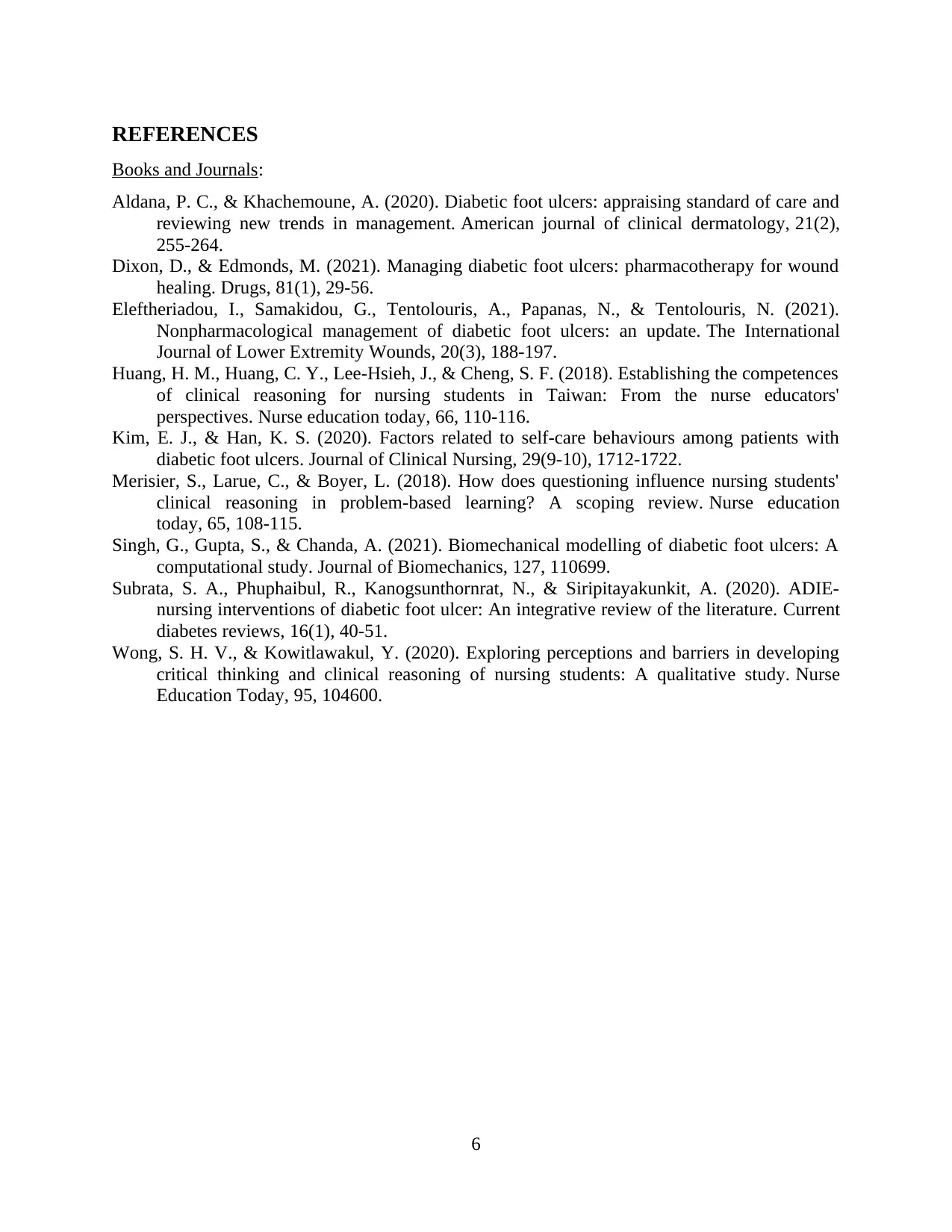
REFERENCES
Books and Journals:
Aldana, P. C., & Khachemoune, A. (2020). Diabetic foot ulcers: appraising standard of care and
reviewing new trends in management. American journal of clinical dermatology, 21(2),
255-264.
Dixon, D., & Edmonds, M. (2021). Managing diabetic foot ulcers: pharmacotherapy for wound
healing. Drugs, 81(1), 29-56.
Eleftheriadou, I., Samakidou, G., Tentolouris, A., Papanas, N., & Tentolouris, N. (2021).
Nonpharmacological management of diabetic foot ulcers: an update. The International
Journal of Lower Extremity Wounds, 20(3), 188-197.
Huang, H. M., Huang, C. Y., Lee-Hsieh, J., & Cheng, S. F. (2018). Establishing the competences
of clinical reasoning for nursing students in Taiwan: From the nurse educators'
perspectives. Nurse education today, 66, 110-116.
Kim, E. J., & Han, K. S. (2020). Factors related to self‐care behaviours among patients with
diabetic foot ulcers. Journal of Clinical Nursing, 29(9-10), 1712-1722.
Merisier, S., Larue, C., & Boyer, L. (2018). How does questioning influence nursing students'
clinical reasoning in problem-based learning? A scoping review. Nurse education
today, 65, 108-115.
Singh, G., Gupta, S., & Chanda, A. (2021). Biomechanical modelling of diabetic foot ulcers: A
computational study. Journal of Biomechanics, 127, 110699.
Subrata, S. A., Phuphaibul, R., Kanogsunthornrat, N., & Siripitayakunkit, A. (2020). ADIE-
nursing interventions of diabetic foot ulcer: An integrative review of the literature. Current
diabetes reviews, 16(1), 40-51.
Wong, S. H. V., & Kowitlawakul, Y. (2020). Exploring perceptions and barriers in developing
critical thinking and clinical reasoning of nursing students: A qualitative study. Nurse
Education Today, 95, 104600.
6
Books and Journals:
Aldana, P. C., & Khachemoune, A. (2020). Diabetic foot ulcers: appraising standard of care and
reviewing new trends in management. American journal of clinical dermatology, 21(2),
255-264.
Dixon, D., & Edmonds, M. (2021). Managing diabetic foot ulcers: pharmacotherapy for wound
healing. Drugs, 81(1), 29-56.
Eleftheriadou, I., Samakidou, G., Tentolouris, A., Papanas, N., & Tentolouris, N. (2021).
Nonpharmacological management of diabetic foot ulcers: an update. The International
Journal of Lower Extremity Wounds, 20(3), 188-197.
Huang, H. M., Huang, C. Y., Lee-Hsieh, J., & Cheng, S. F. (2018). Establishing the competences
of clinical reasoning for nursing students in Taiwan: From the nurse educators'
perspectives. Nurse education today, 66, 110-116.
Kim, E. J., & Han, K. S. (2020). Factors related to self‐care behaviours among patients with
diabetic foot ulcers. Journal of Clinical Nursing, 29(9-10), 1712-1722.
Merisier, S., Larue, C., & Boyer, L. (2018). How does questioning influence nursing students'
clinical reasoning in problem-based learning? A scoping review. Nurse education
today, 65, 108-115.
Singh, G., Gupta, S., & Chanda, A. (2021). Biomechanical modelling of diabetic foot ulcers: A
computational study. Journal of Biomechanics, 127, 110699.
Subrata, S. A., Phuphaibul, R., Kanogsunthornrat, N., & Siripitayakunkit, A. (2020). ADIE-
nursing interventions of diabetic foot ulcer: An integrative review of the literature. Current
diabetes reviews, 16(1), 40-51.
Wong, S. H. V., & Kowitlawakul, Y. (2020). Exploring perceptions and barriers in developing
critical thinking and clinical reasoning of nursing students: A qualitative study. Nurse
Education Today, 95, 104600.
6
⊘ This is a preview!⊘
Do you want full access?
Subscribe today to unlock all pages.

Trusted by 1+ million students worldwide
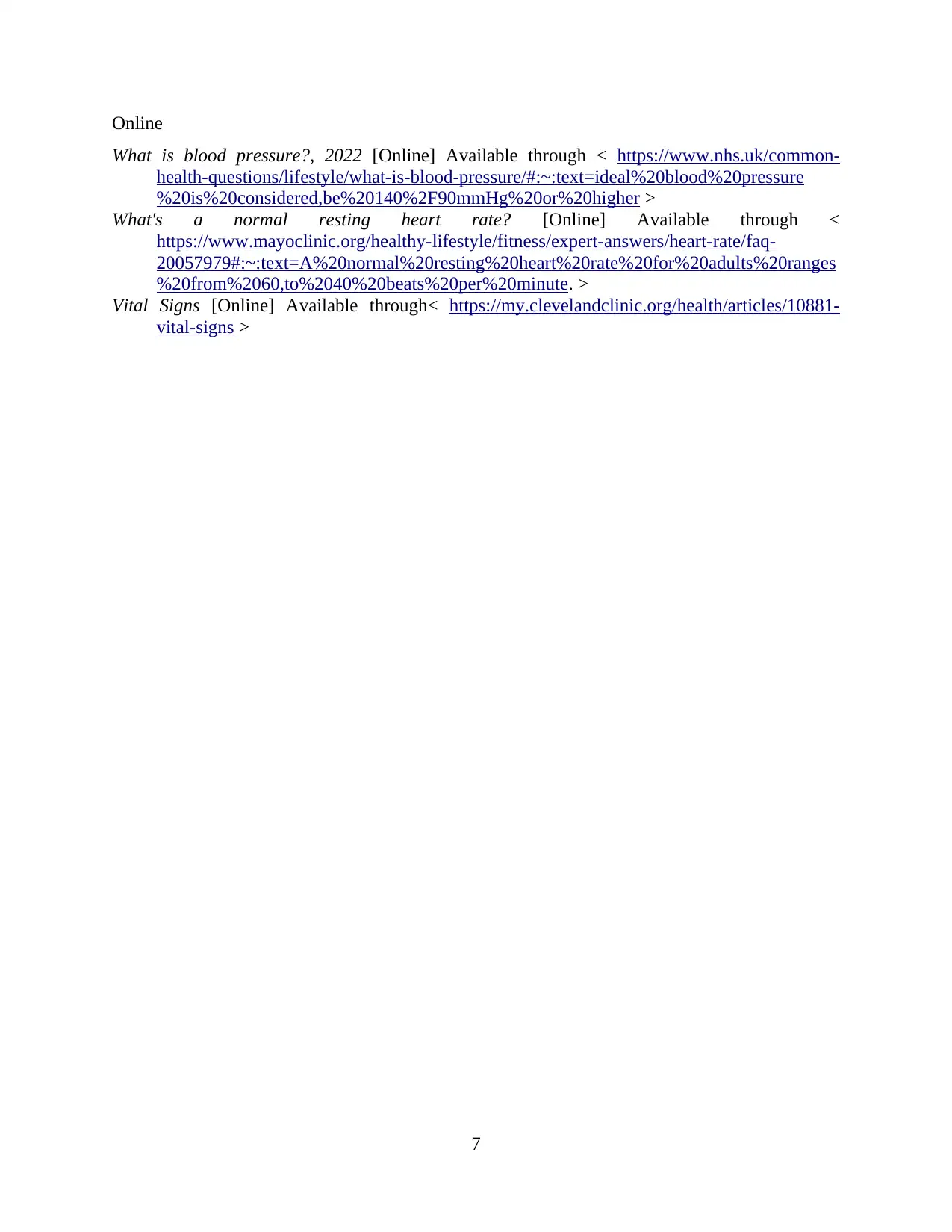
Online
What is blood pressure?, 2022 [Online] Available through < https://www.nhs.uk/common-
health-questions/lifestyle/what-is-blood-pressure/#:~:text=ideal%20blood%20pressure
%20is%20considered,be%20140%2F90mmHg%20or%20higher >
What's a normal resting heart rate? [Online] Available through <
https://www.mayoclinic.org/healthy-lifestyle/fitness/expert-answers/heart-rate/faq-
20057979#:~:text=A%20normal%20resting%20heart%20rate%20for%20adults%20ranges
%20from%2060,to%2040%20beats%20per%20minute. >
Vital Signs [Online] Available through< https://my.clevelandclinic.org/health/articles/10881-
vital-signs >
7
What is blood pressure?, 2022 [Online] Available through < https://www.nhs.uk/common-
health-questions/lifestyle/what-is-blood-pressure/#:~:text=ideal%20blood%20pressure
%20is%20considered,be%20140%2F90mmHg%20or%20higher >
What's a normal resting heart rate? [Online] Available through <
https://www.mayoclinic.org/healthy-lifestyle/fitness/expert-answers/heart-rate/faq-
20057979#:~:text=A%20normal%20resting%20heart%20rate%20for%20adults%20ranges
%20from%2060,to%2040%20beats%20per%20minute. >
Vital Signs [Online] Available through< https://my.clevelandclinic.org/health/articles/10881-
vital-signs >
7
1 out of 10
Related Documents
Your All-in-One AI-Powered Toolkit for Academic Success.
+13062052269
info@desklib.com
Available 24*7 on WhatsApp / Email
![[object Object]](/_next/static/media/star-bottom.7253800d.svg)
Unlock your academic potential
Copyright © 2020–2025 A2Z Services. All Rights Reserved. Developed and managed by ZUCOL.





